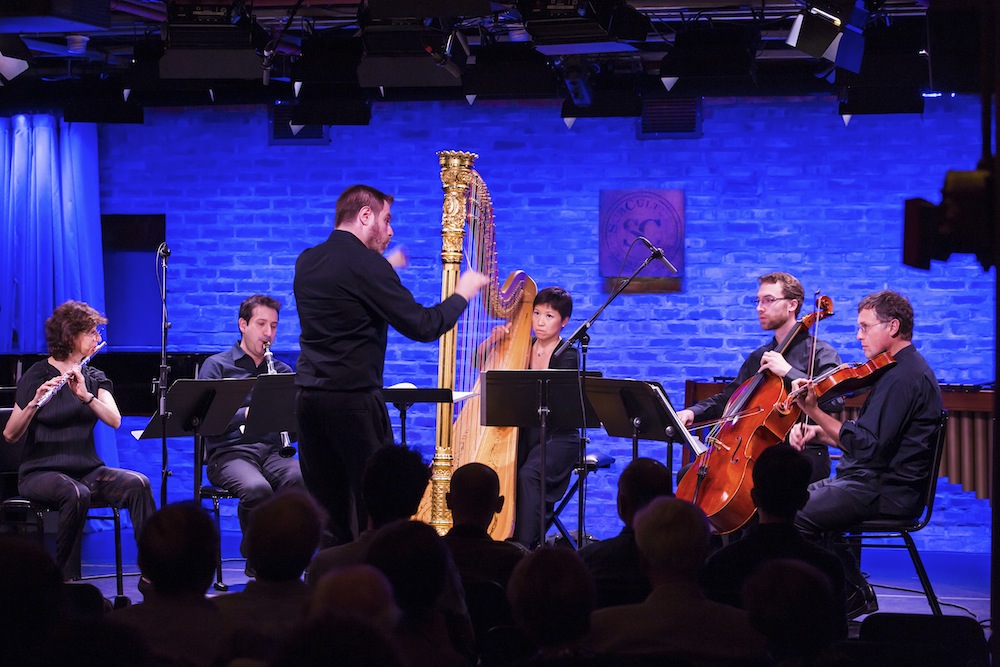NY Phil’s “Contact!” program shows vitality of new Italian composers

Joshua Gersen conducted members of the New York Philharmonic (flutist Mindy Kaufman, clarinetist Pascual Martinez Forteza, harpist June Han, cellist Nathan Vickery and violist Peter Kenote) in Berio’s “Differences for five instruments and tape” Monday night at Subculture. Photo: Chris Lee
Four pieces of music from as many different composers are nowhere near sufficient to comprehensively survey a style or an aesthetic, much less an entire nation. But Monday night at SubCulture, the New York Philharmonic’s CONTACT! new music series used four pieces to demonstrate the continued vitality and depth of “New Music from Italy.”
The range and weight of music produced in the country over the last 100 years is hinted at by some of the most notable names: Gian Francesco Malipiero, Luigi Nono, Bruno Maderna, Walter Marchetti, Luciano Berio. Berio was one of the giants of 20th century classical music, and his influence and importance was honored in the concert, which opened with his Différences for five instruments and tape, a work from the late 1950s.
Différences comes from the period when Berio was dedicated, more or less, to serial atonality (before his style expanded to eclecticism and theatricality), although his use of repetition to achieve transformation went against the prevailing intellectual winds of his time. In this piece, the instruments explore a series of notes, and for a while, the emphasis is on imaginative and carefully created attacks and articulations.
The musicians transform the music, and the accompanying tape transforms them. The tape is first heard about two minutes into the work, playing pre-recorded music that sounds like an echo of things coming from far away and deep in the past. The instrumental sounds on the tape grow increasingly distorted, while the live musicians stay the course, eventually settling on a sequence of intriguing, quasi-tonal chords. Ably conducted by Joshua Gersen, the Philharmonic musicians—violist Peter Kenote, cellist Nathan Vickery, flutist Mindy Kaufman, clarinetist Pascual Martinez Forteza, and harpist June Han—played with exact intonation and close attention to articulation and phrasing in a highly musical performance.
Vittorio Montalti’s impressive and inventive Passacaglia for marimba and cello—Daniel Druckman and Maria Kotsopoulos respectively—came next. Montalti, not yet 40 years old, served as host for the evening, and introducing his piece, talked about the inspiration of Ravel and Fausto Romitelli. From Ravel, he learned the value of repetition, and from Romitelli—an enormously talented composer whose early death left a gaping hole in contemporary music—he learned how to incorporate more populist musical ideas.
Passacaglia is full of surprises and satisfactions. Every bit of Montalti’s use of the theme and variations form is full of creativity: the spare theme, played in the cello, is full of bent notes and shifting attacks; a descending marimba line has a tremendously jazzy articulation (Druckman sounded uncannily like a saxophonist, ghosting notes). The variations extended through dynamics and interplay between the two instruments, and the music touches on the exciting expressive freedom and surprise of free jazz.
The only less than ideal performance of the night was of the third work on the program, Salvatore Sciarrino’s tre duet con l’eco. Montalti prepared the audience well by advising to “listen as if you were in the theater, listening to an opera,” and think of the three instruments—flute, bassoon and viola—as characters. Bassoonist Kim Laskowski also spoke before the music started, using metaphors to express the idea of hearing the piece as not just music but sound.
Sound is essential with Sciarrino, who writes music that sits on the hazy border between silence and noise, and between sound and pitch—his music is like the mind searching for poetic expression when words are inadequate. Laskowski, flutist Yoobin Son, and violist Dawn Hannay clearly were eager to explore the music, but the composer’s aesthetic, though approachable and entrancing, lies far outside the norm of even the contemporary classical repertoire. The volume was a bit too strong and, as odd as it may seem, the musicians played almost too musically, concerned with beauty and fullness of tone, rather than a more murmuring, gestural approach. Sciarrino just had not had sufficient time to soak in.
The final work was Luca Francesconi’s propulsive and explosive Encore Da capo, for flute, violin, clarinet, cello, piano, and tuned percussion. The writing creates tremendous force and gripping intensity out of simple means. This is, essentially, a perpetuum mobile in which the musicians pass around pitches and come together in striking cadences that are both landing and jumping off points. Even at it’s quietest, the music is full of forward drive.
The playing by all—Druckman, Son, violinist Quan Ge, cellist Sumire Kudo, pianist Eric Huebner—was fantastic. There was a high level of listening and cooperation, and the impeccable intonation and precise attacks had a powerful effect. The musicians clearly were wrapped up in the music, and relished working together to bring the piece to life—the performance hurtled along with the power and control of a Ferrari. Clarinetist Anthony McGill, above all, was astonishing, making the extraordinary technical demands of the music appear easy.
CONTACT! continues with New Music From Japan 7 p.m. June 5. nyphil.org.